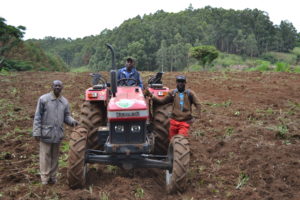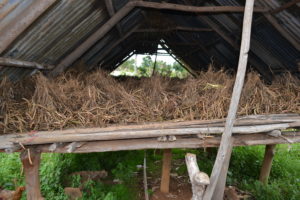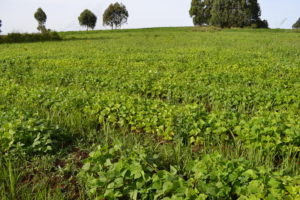Ndu subdivision, Ntumbaw (ntu means hills and mbaw means valleys) village in North-West Cameroon is generally cold in the hills and hot in the valleys. Wilson Nfor Gwei, born in the South West region, Limbe, is a farmer in the region with about 23 hectares of family land and 2 hectares of leased land. Wilson took up farming in 2014 after graduation with a masters in Agriculture and Rural Development from Pan-African Institute of Development, West Africa, Buea campus, Cameroon.
Wilson chose agriculture for a number of reasons. First, his background is agricultural. His father was a field assistant manager with Cameroon Development Cooperation (CDC), an agro-ecological company dealing in palm, rubber, banana and tea until his death in 2001. His Master’s thesis on potato post-harvest handling and valorization also helped him realize unexploited potential in agriculture. He felt the need to bridge the storage gap in order to ensure farmers generate more money selling product during the off seasons and when food is scarce in the market. Agriculture is also seen as a peasant profession in the country, a concept that Wilson wants to amend. Cameroon as a nation experiences a huge youth unemployment issue. In the promotion of agriculture, Wilson encourages youth to make use of available farmland to create income and sustainability for their families. He states that there is need to revamp youth in the country and to ensure they view agriculture as a viable profession.

Wilson tilling his land with the help of a leased tractor. From R to L, Wilson, his friend Diaru, the tractor driver and Mr. Mbuli, an extension worker at MIDENO. (© Wilson Gwei)
In 2014, Wilson felt that agriculture presented a good opportunity for quick income generation. He started farming potato on a trial plot of 4,600 square meters. It did not produce as expected. He then introduced bean on the 4,600 square meters in 2017, and planted potato on 1 hectare of furrow land, because he feared the land previously used was infested with potato blight and other diseases, and had also been used for a long time. He increased the land use to introduced potato on farrow land. The first bean harvest did not bear fruit as expected and Wilson felt he could do better. He assessed the problem and discovered that climatic variation like rain delays or early heavy rain were to blame for the low production. Wilson begun to look for quality seed to introduce to his land.
Martin begun deliberations with Ms. Siri Musongong, an agro-economist with the Institute for Research and Agricultural development (IRAD) Cameroon through his aunt. Siri recommended that he visits the IRAD, Foumbot, West Cameroon office where he met Mr. Martin Ngueguim, an IRAD agronomist. Martin schooled Wilson on the different bean varieties available for different climatic condition. IRAD has between 200 and 300 bean lines, out of which 15 are released varieties. Out of these, Wilson purchased 4 types that were best suited for him since they were commercial varieties which he was looking for, to enable him produce a lot of seed. The selected varieties were; (i) Ecapan 021, a red mottled bush bean variety, (ii) PNN, a black bean bush variety, (iii) BGG, a white bean bush variety, and, (iv) DOR-701, a red climbing variety.
When Wilson returned to Ntumbaw, he identified local influencers like a retired extension officer, leaders in farmer groups and interested farmers to try the new varieties in their farms. One such influencer, the local Baptist Church’s pastor, Rev. Nchanji Godlove bough 1 kilo of each variety to plant within Church as a demonstration plot. Because of this, the pastor created curiosity for the bean, and congregants wondered where it the varieties came from and where to get some for their plots. As a result, more than 15 community members got seed from Wilson and over 50 congregants expressed interest in purchasing the seed for planting in subsequent seasons. Wilson harvested seed that is not yet threshed. His yields were good since he introduced the varieties resistant to climatic variations.
Wilson has constructed a unique method of drying and storage for his bean seed; a 3 by 7 meter hut-like structure made of locally available material of bamboo and iron roofing sheets. Once he establishes that the beans have the correct moisture content, he threshes the beans which then transferred into airtight storage drums with natural insect repellents like hot pepper or eucalyptus leaves. The beans can stay in storage, undisturbed, for upto 3 months.

The structure Wilson put up on his farm for storage and drying of his beans after harvesting (© Wilson Gwei)
Wilson advises the use of crop rotation. It has helped him in soil management since nitrogen fixating beans have made his land fertile and have helped in pest and disease management. Inter cropping between beans and potato has encourages better yields for the potato in subsequent seasons. He also advises farmers to keep beans not only for planting in the next season, but also to use in the household to boost nutrition. He observes that a lot of the local farmers sell all their seed leaving nothing for the home. He encourages investment in agriculture like inputs e.g. quality seed and fertilizers, not only to help in fighting food insecurity, but also improve on household sustainable income.
Wilson plans to introduce other crops to his land like maize, which he will use as stakes for his climbing bean varieties. He has started multiplying seed and is in the process of working with the Cameroonian government to become a certified bean seed multiplier. He also plans to increase production of beans on his land. Wilson, who is currently working with a youth group and a women group, wants to increase participation to enable marketing as a group. It is also easier for extension officers from the ministry of agriculture to help on their plots as well as reception of farm inputs for free or at a subsidized rate.
Not all games contribute the same to wagering requirements. The benefit of an acca is obvious, particularly if you are backing short price favourites. Last updated & tested: 2020-05-09 https://betzoid.com/. In tournament tennis, there are two sides to the draw, from which the two finalists will make their route to the final.


